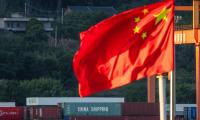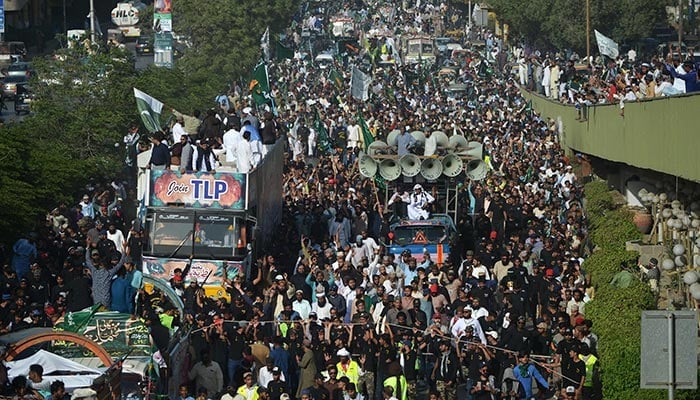TLP to face challenges due to founder’s absence, ‘uninterested’ power circles
In other words, Faizabad sit-in was unquestionably first introduction to the TLP and its founder Khadim Rizvi
LAHORE: Religio-political party Tehreek-e-Labbaik Pakistan (TLP) was founded by Khadim Hussain Rizvi in 2015. The far-right party emerged after the hanging of Mumtaz Qadri, who had killed Salman Taseer, the governor of Punjab. Rizvi had justified the murder of Salman Taseer. The wheelchair-bound cleric travelled across the country to build support for Section 295-C of the Pakistan Penal Code, which deals with blasphemy.
Before the Faizabad Interchange sit-in in 2017, few people knew about the white-bearded cleric, who had paralysed twin cities, Islamabad and Rawalpindi of the country. In other words, the Faizabad sit-in was unquestionably the first introduction to the TLP and its founder Khadim Rizvi. It was the moment when the state knew the street power of the TLP, as the police failed to uproot the sit-in, organised by Khadim Hussain Rizvi. There were governments of the PMLN in Punjab as well as in centre.
The government got weakened in a Panama case after a verdict of the court. The TLP marched from metropolitan city of the Punjab province to the capital city of the country, seeking resignation of the then law minister Zahid Hamid, who belonged to the PMLN, as he was alleged to have caused a change in the bill of “2017 Election of Pakistan” to favour a minority community. Rizvi received support from the public, religio-political parties of the country and other factions of society. Major cities of the country were crippled at the hands of the cleric. The then government launched an operation, resulting in violent clashes between supporters of Rizvi and the security forces. By late evening, the army chief intervened and asked “both sides” to show restraint. A settlement was made, and as a result all arrested were released, and the sit-in ended. Former ISI DG Faiz Hameed was the guarantor.
After that protest, Khadim Rizvi proved himself an undaunted religious leader in the Barelvi faction. From here, the revival of the Barelvi school of thought started in the country. Furthermore, the Faizabad sit-in showed that the Barelvis could turn violent and could get their demands accepted from the state, and the state pillars seemed helpless.
The Supreme Court had taken suo motu notice and issued a verdict to remove the protesters. Before the protest, the Barelvi faction was considered submissive. Religious politics of Khadim Rizvi compelled other factions to follow him. The TLP became more powerful than other religio-political parties. It gained power from protests, whether it was protesting against the acquittal of Asiya Bibi by the court or demanding expulsion of the French ambassador from the country.
In 2021, the TLP started violent protests in Lahore and the rest of the country. Many policemen were martyred and injured. Clashes started between the TLP protesters and police officials.
Some TLP activists also died in clashes. Imran Khan’s government declared them a banned outfit. After immense pressure, negotiations opened with the TLP leadership, including with Saad Rizvi, who was in jail. The TLP was removed from the list of banned outfits and the names of their activists were removed from the list of the fourth schedule as well.
The Barelvi clerics associated with the TLP, in particular, seem to have gained electoral support as the party emerged as the largest religio-political party in the 2018 general election. Furthermore, the TLP came to limelight in the 2018 elections when it emerged as the fifth largest party in Pakistan, securing 2.2 million votes. While the TLP was unable to win any seats in the National Assembly, it clinched three seats in the Sindh Assembly in the 2018 polls.
Some political analysts believe that though the TLP has street power, its candidates would not get too many votes in the February 8 elections like in 2018, because of the absence of charismatic and firebrand cleric Khadim Hussain Rizvi. They also believe that in 2018, the power circles were also supporting the TLP because they wanted to divide the religious votes of the PMLN and they did it successfully. They further said that Khadim Rizvi knew it well when to stage a protest and how to engage the power circles in backdoors negotiations to get political support.
Right now, the powerful circles seem least interested in Saad Rizvi’s politics. A comparison between the 2018 elections and the 2022 by-elections will be a reasonable way to assess where the TLP stands currently. “In 2018, the TLP had emerged as the third largest party in the Punjab, with 1.9 million votes. On the other hand, in the 2022 by-elections, held in the Punjab, the party clinched only five per cent of the votes – a significant decline compared to 2018.”
Some analysts also believe that Saad Rizvi had proved himself as true successor of his father and cemented himself as true leader after he successfully resolved crises within the party and outside.
Now, the TLP has fielded its candidates in almost all constituencies, especially in Punjab and Sindh provinces. It has already launched its manifesto, consisting of 25 points, promising to give the minorities their rights as per the constitution of Pakistan. The party will go ahead with its religious identity. It will introduce a ‘panchayat’ system for speedy and affordable justice. The TLP will get rid of the country’s international debts, but the plan and mechanism were not discussed in the party manifesto. Separate education institutions for girls will be established.
-
 2026 Jobs Outlook: Global Unemployment Hits 4.9%, Decent Work Deficit Widens
2026 Jobs Outlook: Global Unemployment Hits 4.9%, Decent Work Deficit Widens -
 NHS Issues 'eight-week' Warning For Omeprazole Users
NHS Issues 'eight-week' Warning For Omeprazole Users -
 Details Of Kate Middleton 44th Birthday Celebrations With Family Revealed
Details Of Kate Middleton 44th Birthday Celebrations With Family Revealed -
 Elon Musk Introduces Subscription Model For Tesla FSD In Strategic Move
Elon Musk Introduces Subscription Model For Tesla FSD In Strategic Move -
 Prince Harry To 'soft Launch' Meghan Markle As They Test Return To Royal Life
Prince Harry To 'soft Launch' Meghan Markle As They Test Return To Royal Life -
 Meghan Markle 'strict Personal Conditions' For UK Trip Come To Light
Meghan Markle 'strict Personal Conditions' For UK Trip Come To Light -
 Kiefer Sutherland Detained For Allegedly Assaulting Ride-share Driver In Hollywood
Kiefer Sutherland Detained For Allegedly Assaulting Ride-share Driver In Hollywood -
 Is Hytale Worth Playing? Here’s Everything You Need To Know
Is Hytale Worth Playing? Here’s Everything You Need To Know -
 Google Photos Tests Battery-saving Backup Option
Google Photos Tests Battery-saving Backup Option -
 China Defies Trump Tariffs As Trade Surplus Hits Record $1.2T In 2025
China Defies Trump Tariffs As Trade Surplus Hits Record $1.2T In 2025 -
 No Hopes Of Royal Reunion As King Charles Set To Dodge Prince Harry
No Hopes Of Royal Reunion As King Charles Set To Dodge Prince Harry -
 Taiwan Issues Arrest Warrant For OnePlus CEO Pete Lau
Taiwan Issues Arrest Warrant For OnePlus CEO Pete Lau -
 Evan Peters Reveals What Brought Him Back To 'American Horror Story'
Evan Peters Reveals What Brought Him Back To 'American Horror Story' -
 Google Meet Adds Automatic Room Check-in On Mobile Devices.
Google Meet Adds Automatic Room Check-in On Mobile Devices. -
 A New “living Drug” Offers Hope For Patients With Aggressive Blood Cancer
A New “living Drug” Offers Hope For Patients With Aggressive Blood Cancer -
 US Formally Approves Nvidia H200 Chip Exports To China: What Conditions Are In Place?
US Formally Approves Nvidia H200 Chip Exports To China: What Conditions Are In Place?




